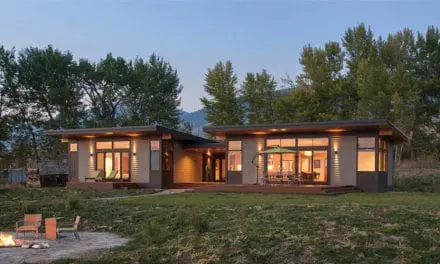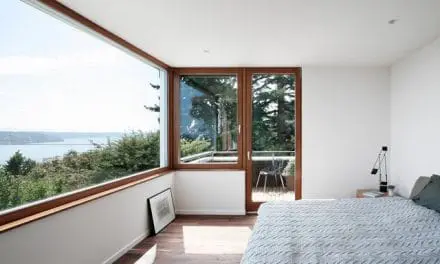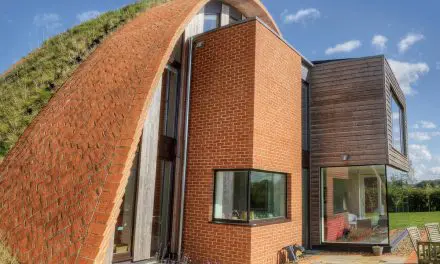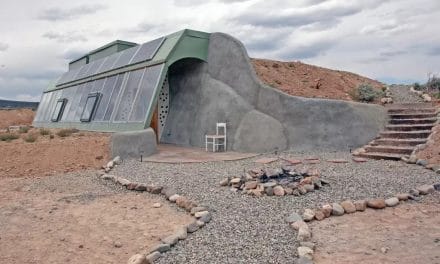Big Lessons We Can Learn from the Tiny House Movement

Listen and Learn!
This comes courtesy of our friends at Build Your House Yourself University hosted by Michelle Nelson, informal residential construction student. She shares information on home building practices as well as interviews with experienced contractors and industry experts to bring you tips, tricks, and trends in home building.
Most people are not considering building a tiny house. Most of us want homes that are larger, in fact MUCH larger, than a typical tiny home. Mobile, trailer-ready tiny homes are usually between 100 and 300 square feet and tiny homes with a permanent foundation can be up to 600 square feet. To put that into perspective, according to reference.com, the average American bedroom in a new home is between 120 and 150 square feet. And master bedrooms are usually larger, averaging more than 200 square feet. That 200 square feet, by the way, does not take into account the master closet space or the master bathroom.
The closest any of us will ever come to tiny living will be the time that we spend in a stateroom, on a cruise ship. The average room on a cruise ship is 150 to 200 square feet. So, If you can’t imagine your whole house fitting into such a small space, a tiny house is probably not for you. But, even if you have no desire to live in just a few hundred square feet, there are many lessons that we can learn from the tiny house movement. We’ll talk about those lessons in just a minute but, first, let me ask you a question.
Do you know the difference between cement and concrete? No? Well, I didn’t either, that’s why those are the pro terms for today. Cement and concrete.
Although the terms cement and concrete often are used interchangeably, they’re not the same. Cement is actually a component of concrete. Cement along with aggregates like sand, gravel or crushed stone, are added together to make concrete. Cement is a fine powder of limestone and other ingredients that act like a binder, holding the materials of concrete together.
Cement is a fine powder of limestone and other ingredients that act like a binder, holding the materials of concrete together.
Cement usually makes up from 10% to 15% of the total mass of concrete; but the exact proportions can differ from mixture to mixture, depending on which type of concrete is being made.
The two main forms of cement are hydraulic cement and non-hydraulic cement. Hydraulic cement hardens when exposed to water and non-hydraulic cement does not harden with water.
Portland cement, which you may have heard of, is a hydraulic cement and it is the most common type of modern cement used around the world today. Portland cement dries quickly and has a higher compression strength when compared to other cements. Portland cement is great for use in concrete, mortar, grout, and stucco.
So, concrete is the stone-like structure formed after cement and other materials are mixed together. The cement is like a binder that is just one part of the concrete recipe. You can’t make concrete without cement.
Now, let’s get to those 10 big lessons learned from the tiny house movement.
#1 Get rid of clutter before you move into your new home.
Have you ever watched an episode of that tv show “Hoarders” and thought to yourself, “I’m not like that, am I?” The truth is, although most of us are not hoarders, many of us have far more STUFF than we actually need. Decluttering is a must for most people moving into a tiny house. But decluttering is also a good idea for most anyone who’s moving into a new home, especially if you are moving into your newly custom built dream home. You don’t want to carry your clutter to your dream home. I don’t know why, but stuff just sort of accumulates over time and instead of it being a source of pleasure, it can become a source of stress, an eyesore. All that stuff can just become one more thing on our to-do list. How many times have you said to yourself “ I have got to clean out that garage.”
Here’s a good rule of thumb: Get rid of anything that you haven’t used or worn in the last 6 months. If that seems too drastic, change that to a year. If you haven’t needed it in a whole year, you probably don’t need it. Although most of us will have more storage space than those living in a tiny house, we don’t want to fill that storage space up with junk— stuff that we really don’t need. Purge, people, purge!
For some reason, getting rid of clutter makes us feel better. You know that great feeling you get when you clean out your car, or your garage, or your closet? Times that by 100 when you declutter your whole house. Gently used items can be given to your local Salvation Army or Goodwill. And that should make you feel even better.
Start paring down a little at a time, several months to even a year before you plan to move. Dedicate maybe a half hour a couple of nights per week, or one hour on the weekends, to go through drawers, closets and shelves. Get rid of what you haven’t used and what you no longer need or want. If you have lots of sentimental items, keep only your top 3 to 5 or 10 items and take pictures of the other things so you can archive them in your computer or in a photo book that you can get from Vistaprint.com or shutterfly.com
Finally, after we’ve built, moved into, and adequately furnished our new homes, how do we keep our dream homes clutter-free? Again, let’s learn from owners of tiny homes. Here’s a general rule that many of them live by: if you buy something new, get rid of something old. You can rid yourself of those things by donating them, selling them, recycling them or throwing them away. But if something new comes in the house, something old has to come out.
#2 Bigger is not always better.
I know that’s not profound, but sometimes we need to be reminded of it. Having plenty space definitely has its advantages, but usually the more space you have the larger your mortgage, furniture bills and utility bills. Eliminating excess space from your house plan could significantly decrease your expenses, both during and after construction. In addition, less space means less room for clutter and less time doing housework and maintenance. That translates into less stress and more quality time for yourself and your family. So, strongly consider how much space you actually need to be happy. Speaking of which, our third lesson is to…
#3 Try out spaces for size and comfort BEFORE you build.
Our home is the biggest investment that most of us will ever make— although that might not be true for tiny house dwellers. But for most of us, yes, its the biggest investment. So, like those who are moving into a tiny house, we should try spaces out for size before we design and build them– before you spend all the time, energy and money that it takes to build a house. Here’s what I mean.
Go to open houses, models homes and even the homes of your friends and family and see how the size of the homes feel to you. Does a 1500 square foot home or 3500 square foot home feel more like you? Or maybe it should be something in between. Visit houses of various sizes and see what size house feels too big or too cramped? Go into bedrooms and figure out what size you want your guest and master bedrooms to be.
Be especially mindful of small spaces like powder rooms, toilet rooms in your master bath, showers and laundry rooms. Determine how small is too small for you.
You could carry a measuring tape around, but you could also do what I do most of the time. Just walk it out. Most people’s feet are about one foot long, unless you have unusually small or large feet. You can get of rough estimate of how large a space is by walking heel to toe across the space. My husband hates when I do that, but because I’ve done it so many times, I have a pretty good idea of how we should design our home.
For example, I know that I don’t want any showers in our house to be smaller than 3×4 feet. I determined that by standing in and walking the dimensions of many showers. I also concluded that even though they are more expensive, I definitely want high ceilings. And I know that what I once thought was a perfect size for a guest room, 15×15 feet, is way too large. I want my guests to feel at home, but I also want them to GO HOME, you know what I mean?
So take some time and try out different spaces before you build your home. Take notes in your phone, or on paper, and pull that information out when you’re deciding on house plans.
#4 Make most rooms multifunctional.
In episode 5, called “Home trends 2016, Lessons learned at the International Builders Show”, we talked about flexible, multipurpose rooms. It’s one of the hot trends for standard sized homes. And, as you can imagine, it’s not only a trend, but a necessity for tiny homes. Most spaces in tiny homes have multiple functions.
Why not use your guest bedroom as an office when you don’t have guests (which is most of the time)? Your laundry room can double as a crafting space and your mud room can also house your pet crates and litter boxes.
Think about how all the rooms in your house can be utilized regularly, instead of just occasionally. If your house plans include a space that will only get used a few times a year, consider eliminating that space all together. For example, if you only use a formal dining room once a year at Thanksgiving, think about eliminating the formal dinner room and expanding your kitchen to accommodate a larger table or maybe making your great room a little bigger so it can hold a large dining table.
If you do decide that you need to include a rarely used formal dining room because you think you need it to improve the resale value of your home, let your children use the formal dining room to do their homework for most of the year. Then, when its time for a holiday dinner, hide their school books and supplies in a designated cabinet in the buffet or the butler’s pantry.
#5 Eliminate dead or wasted space.
There is no reason to include dead spaces in ANY home, tiny or otherwise. A dead space is an area of the house where there is no furniture and no purpose. Dead spaces increase the size of your house without increasing your home’s comfort or function. Sometimes framers will close off extra, potential storage space in a house so that finished rooms are perfectly symmetrical. But if you want the most storage space you can get, go over your plans with your framer and ask them where wasted space can be eliminated. If you are having your plans drawn up, tell your designer that you want as little wasted space as possible.
Sometimes framers will close off extra, potential storage space in a house so that finished rooms are perfectly symmetrical. But if you want the most storage space you can get, go over your plans with your framer and ask them where wasted space can be eliminated. If you are having your plans drawn up, tell your designer that you want as little wasted space as possible.
Think of stairwell landings, the area under your stairwell and hallways. With a little extra thought, some home designers can completely eliminate hallways and make the space under your stairs a coat closet, powder room or playroom for your children. Stairwell landings can be used as reading nooks with book shelves or a small seating area.
#6 Use your vertical space.
If you have to have hallways, add book shelves for storage. Using vertical wall space is a must for tiny homes, but standard size homes can also benefit from utilizing vertical space. Extra shelving can be added above toilets, above your washer and dryer, in your mudroom, in your garage or on any empty wall where extra storage is needed. You can also use hooks and a peg board system to take advantage of vertical spaces.
#7 Expand your living area to the outdoors.
Since the indoor space in tiny houses is limited, many people expand their living area by utilizing decks and porches for dining, relaxing and entertaining. This is especially true for those living in warmer climates, but even those in cooler areas can enjoy outdoor living with the used of fire pits and outdoor heaters. Like tiny house dwellers, we can put chairs and a coffee table outside and create an outdoor living room, or place a dining table outside so we enjoy meals outside whenever weather permits.
#8 Add a loft for bonus living space.
Almost all tiny houses have a loft space, which are typically used as a bedroom. Standard sized houses can also include loft spaces. They can be used as a home office, lounge or homework area for your children. You can add a sofa bed to the space and make your loft a guest room. I’ve also seen lots of lofts spaces used as game rooms or home theaters. A loft allows us to make a second floor space functional without the extra expense adding framing, drywall, and doors.
#9 Cantilever walls and windows for added space and interest.
Pop Quiz: Do you remember what a cantilever is? Cantilever was our pro term in episode 17 called “Size matters, but so does design.” In that episode, I gave you a list of 20 money saving design and construction features and i mentioned a cantilever. Can you remember what it is?
A cantilever is simply a “bump out” that extends from the side of a house. Cantilevered designs can increase the space in a room without having to expand the home’s foundation footprint. The most common cantilevered designs extend about 2 or so feet beyond a home’s wall.
Because tiny houses have such a small footprint, cantilevers are a great way to expand a room without adding to that footprint of the house. The same principle is true for standard sized houses. Bumping out a window or wall can give you a greater sense of space without increasing the cost of your foundation. This is an especially good trick for houses that will build on smaller lots.
#10 Build a kitchen for cooking, not just for looking.
Most people want a good looking kitchen, even people living in tiny homes, but like tiny home dwellers, we should design our kitchen with efficient work stations and only the appliances that we actually need. If you are not a big cook, you can probably forgo the expensive, professional grade appliances. And remember, just because they make an appliance, doesn’t mean you have to include it in your kitchen.
For example, it’s really trendy right now to include those fancy espresso makers in custom build homes, but since my husband and I aren’t coffee drinkers, we won’t be including a coffee station in our kitchen. Steamers, warming drawers, refrigerator and freezer drawers, those things are all nice, but ask yourself if you’ll really use them.
Build your kitchen for beauty, but also for efficiency. Only you can decide what’s important for you and your family, but carefully consider every appliance. Cluttering your kitchen with extra and oversized features and appliances might not be the best use of your space or your money.
Most homeowners aren’t willing or able to change from a standard sized house to a tiny home, but any homeowner can take away some lessons from tiny house living.
We’re all finished for this week. Hopefully, you found some of the principles and practices of tiny house living helpful.
If you just stumbled upon this show, you might want to go ahead subscribe to it. That way you’ll always be able to find us under the “my podcasts” tab. I can’t tell you how many times I’ve stumbled upon a podcast, loved it, did not subscribe and forgot the name of the show. Then I was unable to find it again. So, if you want to subscribe in itunes, start by searching for BYHYU and tapping the purple subscribe tab that’s towards the top right of the screen.
Please remember that the purpose of this podcast is simply to educate and inform. It is not a substitute for professional advice. The information that you hear is based the only on the opinions, research and experiences of my guests and myself. That information might be incomplete and it’s subject to change, so it may not apply to your project. In addition, Building codes and requirements vary from region to region, so always consult a professional about specific recommendations for your home.
Featured image courtesy of Ben Chun (CC BY-SA 2.0)








